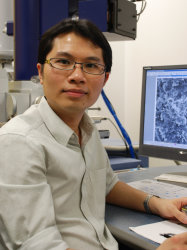Summary
My research concerns the microstructure, durability and sustainability of cementitious materials. The aim is to develop more durable and sustainable concrete structures by understanding how material composition, processing and exposure conditions influence microstructure development, macroscopic engineering properties and long-term performance. Key questions that drive my work are: a) How to quantify complex, multiscale and multiphase microstructure? b) How do pores, cracks, interfaces and phase assemblage influence mass transport and deterioration processes? c) How to assess current performance and predict long-term behaviour? d) How to re-engineer the microstructure to produce novel materials with enhanced performance at lower environmental impacts?
Examples of research include developing three-dimensional imaging and quantitative analysis of microstructure, understanding the effects of pores, microcracks and interfaces, modelling transport from microstructure and petrographic assessment of concrete composition and water/cement ratio. More recently, I have worked on developing zero-carbon cement from magnesium silicates, supplementary cementitious materials from excavated waste clay, limestone calcined clay cement, durable reinforcement spacers, self-healing concrete, epoxy polymer concrete, hydrophobic concrete, and clogging-resistant permeable concrete (Kiacrete)..
Within the Department of Civil & Environmental Engineering, I am the Undergraduate Year 2 Coordinator, Course Director for the Advanced Materials for Sustainable Materials MSc programme and Laboratory Director for the Centre for Infrastructure Materials. I teach modules on Materials, Cementitious Materials, Concrete Materials, and Structural Mechanics, and was the recipient of the 2017 CivSoc Student Choice Award for Best Lecturer.
Other activities
Other contributions include Steering and Scientific Committee membership of Innovandi, the global cement and concrete research network, and as Chair of the Scientific Committee and Steering Committee member of Nanocem. I serve on the Executive Committee of Applied Petrography Group, an industry-led group on the use of petrographic methods for construction materials, and contributed to the development of BS 1881-211:2016 on the petrographic examination of hardened concrete. I am also involved in the APG inter-laboratory trial on microscopy techniques for determining water/cement ratio in hardened concrete, the RILEM TC 262-SCI on the steel-concrete interface, and RILEM TC 286-GDP on gas diffusion in porous media. I am the co-founder of zero-carbon cement start-up Seratech and high-strength clogging-resistant permeable concrete (Kiacrete) start-up Permia (patent WO2020099868), and a consultant on a range of industry projects linked to my research thru Imperial Consultants (ICON).
Background
Growing up in Kuala Lumpur, I was trained as a civil engineer at the University of Malaya, gaining a first-class honours BEng and a research MSc on calcined clay for high-performance concrete. I then completed a PhD in quantitative backscattered electron microscopy at Imperial and the thesis was awarded the W.C. Unwin prize. Following that, I was a Research Associate on modelling mass transport processes using the techniques developed during my doctoral studies and was appointed as an academic staff in 2010. When not working, I am busy raising two hyperactive kids. As an amateur blues-rock guitarist, I am always keen to link with other like-minded musicians.
Links
Scopus | Scholar | ORCiD | ResearchGate | WoS
Expertise
Cement and concrete materials, microstructure, petrography, porous media, mass transport, durability, sustainability, low-carbon construction.
Selected Publications
Journal Articles
Wu Z, Wong HS, Buenfeld NR, 2017, Transport properties of concrete after drying-wetting regimes to elucidate the effects of moisture content, hysteresis and microcracking, Cement and Concrete Research, Vol:98, ISSN:0008-8846, Pages:136-154
Alzyoud S, Wong HS, Buenfeld NR, 2016, Influence of reinforcement spacers on mass transport properties and durability of concrete structures, Cement and Concrete Research, Vol:87, ISSN:1873-3948, Pages:31-44
Abyaneh SD, Wong HS, Buenfeld NR, 2016, Simulating the effect of microcracks on the diffusivity and permeability of concrete using a three-dimensional model, Computational Materials Science, Vol:119, ISSN:0927-0256, Pages:130-143
Lee HXD, Wong HS, Buenfeld NR, 2016, Self-sealing of cracks in concrete using superabsorbent polymers, Cement and Concrete Research, Vol:79, ISSN:1873-3948, Pages:194-208
Yio MHN, Mac MJ, Wong HS, et al., 2015, 3D imaging of cement-based materials at submicron resolution by combining laser scanning confocal microscopy with serial sectioning, Journal of Microscopy, Vol:258, ISSN:0022-2720, Pages:151-169
Wu Z, Wong HS, Buenfeld NR, 2015, Influence of drying-induced microcracking and related size effects on mass transport properties of concrete, Cement and Concrete Research, Vol:68, ISSN:0008-8846, Pages:35-48
Wong HS, Barakat R, Alhilali A, et al., 2015, Hydrophobic concrete using waste paper sludge ash, Cement and Concrete Research, Vol:70, ISSN:1873-3948, Pages:9-20
Abyaneh SD, Wong HS, Buenfeld NR, 2014, Computational investigation of capillary absorption in concrete using a three-dimensional mesoscale approach, Computational Materials Science, Vol:87, ISSN:0927-0256, Pages:54-64
Yio MHN, Phelan JC, Wong HS, et al., 2014, Determining the slag fraction, water/binder ratio and degree of hydration in hardened cement pastes, Cement and Concrete Research, Vol:56, ISSN:0008-8846, Pages:171-181
Dehghanpoor Abyaneh S, Wong HS, Buenfeld NR, 2013, Modelling the diffusivity of mortar and concrete using a three-dimensional mesostructure with several aggregate shapes, Computational Materials Science, Vol:78, ISSN:0927-0256, Pages:63-73
Wong HS, Buenfeld NR, Matter K, 2013, Estimating the original cement content and water-cement ratio of Portland cement concrete and mortar using backscattered electron microscopy, Magazine of Concrete Research, Vol:65, ISSN:0024-9831, Pages:693-706
Wong HS, Zimmerman RW, Buenfeld NR, 2012, Estimating the permeability of cement pastes and mortars using image analysis and effective medium theory, Cem. Concr. Res., Vol:42, Pages:476-483

